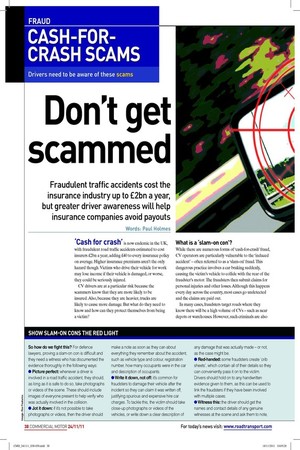SHOW SLAM-ON CONS THE RED LIGHT
Page 30

Page 31

If you've noticed an error in this article please click here to report it so we can fix it.
So how do we fight this? For defence lawyers, proving a slam-on con is difficult and they need a witness who has documented the evidence thoroughly in the following ways: ● Picture perfect: whenever a driver is involved in a road traffic accident, they should, as long as it is safe to do so, take photographs or videos of the scene. These should include images of everyone present to help verify who was actually involved in the collision.
● Jot it down: if it’s not possible to take photographs or videos, then the driver should make a note as soon as they can about everything they remember about the accident, such as vehicle type and colour, registration number, how many occupants were in the car and description of occupants.
● Write it down, not off: it’s common for fraudsters to damage their vehicle after the incident so they can claim it was written off, justifying spurious and expensive hire car charges. To tackle this, the victim should take close-up photographs or videos of the vehicles, or write down a clear description of any damage that was actually made – or not, as the case might be.
● Red-handed: some fraudsters create ‘crib sheets’, which contain all of their details so they can conveniently pass it on to the victim. Drivers should hold on to any handwritten evidence given to them, as this can be used to link the fraudsters if they have been involved with multiple cases.
● Witness this: the driver should get the names and contact details of any genuine witnesses at the scene and ask them to note, for future recollection, how many people were involved in the incident and the circumstances in which it occurred.
● Police reports: it’s also a good idea to call the police and ask them to note down that the other driver appeared to brake for no apparent reason and that the circumstances were suspicious.
Communication is the key
While it is important for motorists to remember all of the advice above, it’s crucial that all road users are told about slam-on cons. More often than not, drivers do not know they have been a victim of a scam.
They could be shocked and concerned that they were to blame for the accident – and it is this confusion that the fraudster relies on. The commotion at the scene can put the fraudster at an advantage as it prevents the driver from properly assessing the situation and can lead them to believe that they were at fault and the claim is then paid.
Transport operators should have a proce dure and culture where drivers are encouraged to tell their managers if they believe they have been a victim of a fraud. The management must ensure that this is accurately reported to the insurance company or claims department. All too often, drivers don’t report their concerns fully, or if they do, they don’t get reported back due to lack of education or a breakdown in communications.
By teaching drivers about this type of insurance scam, they can help insurers and lawyers put a firm brake on slam-on cons.













































